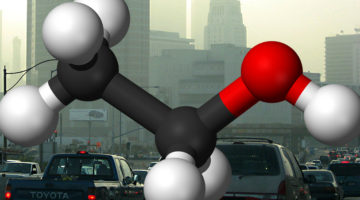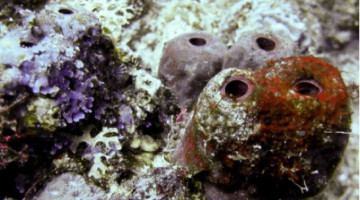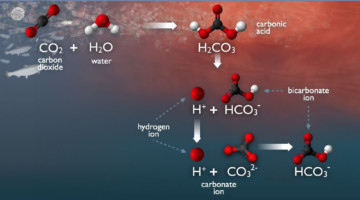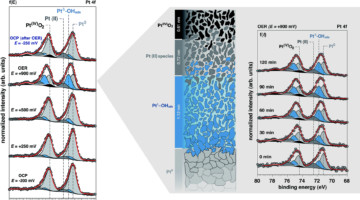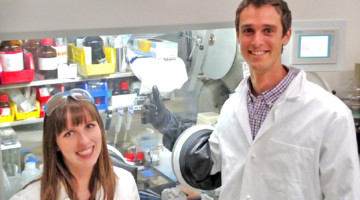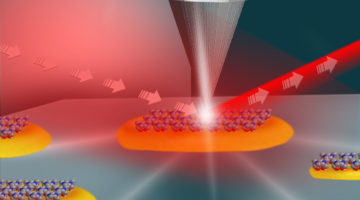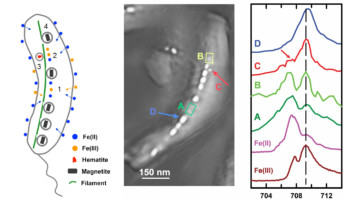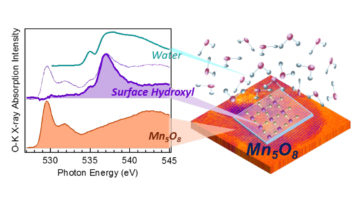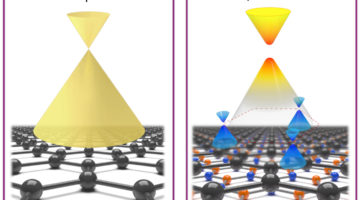X-ray experiments, coupled with theoretical work, revealed how oxygen atoms embedded near the surface of a copper sample had a more dramatic effect on the early stages of a reaction with CO2 than accounted for in earlier theories. This work could prove useful in designing new catalysts for converting CO2 into liquid fuels and other products. Read more »
ALS Work Using Spectroscopy
These techniques are used to study the energies of particles that are emitted or absorbed by samples that are exposed to the light-source beam and are commonly used to determine the characteristics of chemical bonding and electron motion.
Bacterial Symbiont Sequesters Arsenic and Barium in Sponges
Researchers used x-ray fluorescence, spectroscopy, and diffraction to study how populations of symbiotic bacteria can act as a detox organ in a host with no organs. The bacteria, members of the species Entotheonella, accumulate and mineralize large quantities of arsenic and barium in sponges. Read more »
APXPS Finds Carbonate Reversal at Liquid Interfaces
Aqueous carbonate systems are central to many processes essential to life, from the blood buffer system to the global carbon cycle. Using APXPS, researchers probed the concentration of carbonates near an interface, finding a surprising reversal in the expected abundances as a function of depth. Read more »![]()
![]()
A Closer Look at a Working Platinum/Electrolyte Interface
Ambient-pressure studies of the interface between a platinum electrode and an alkaline electrolyte revealed the molecular-level chemistry, structure, and dynamics of the platinum surface as a function of applied potential, highlighting differences between thermodynamic predictions and the actual surface composition. Read more »
Strain Turns Tin into a 3D Topological Dirac Semimetal
A small amount of compressive strain turns a nonmetallic form of tin into a 3D topological Dirac semimetal—a kind of “supermetal” with very high electron mobility. With its rich topological phase diagram, the material shows promise for both novel physics and eventual device applications. Read more »![]()
![]()
Modulating Infrared Light with 2D Black Phosphorus
Two-dimensional materials represent a promising new frontier in the field of optoelectronics. Most progress so far, however, has been in the visible-light range. Now, at the ALS, researchers have measured the infrared transmission spectra of ultrathin samples of black phosphorus under an applied electric field. Read more »![]()
![]()
Mapping Catalytic Reactions on Single Nanoparticles
A new study confirms that structural defects and jagged surfaces at the edges of platinum and gold nanoparticles are key hot spots for chemical reactivity. The experiments should help researchers customize the structural properties of catalysts to make them more effective in fostering chemical reactions. Read more »![]()
![]()
Ptychography of a Bacterium’s Inner Compass
Magnetotactic bacteria (MTB) synthesize chains of magnetic nanocrystals (magnetosomes) that interact with the Earth’s magnetic field like an inner compass needle, simplifying their search for optimum environments. Ptychographic spectra of magnetosomes from a marine MTB provides insight into how these inner compasses form. Read more »
For Better Batteries, Open the Voltage Window
Electrochemical (battery) cells with aqueous electrolytes can be safe, inexpensive, and environmentally friendly, but they are limited by a narrow voltage window. X-ray absorption spectroscopy helps explain why an aqueous Na-ion system with Mn5O8 electrodes has a large voltage window and performs comparably to Li-ion batteries. Read more »
Altered States in Graphene Heterostructures
ARPES directly reveals for the first time how electronic states are altered when epitaxial graphene is deposited on a substrate of hexagonal boron nitride (h-BN). The interaction between the materials in this heterostructure greatly improves its suitability for advanced, ultralow-power device applications. Read more »![]()
![]()
- « Previous Page
- 1
- …
- 22
- 23
- 24
- 25
- 26
- …
- 30
- Next Page »
